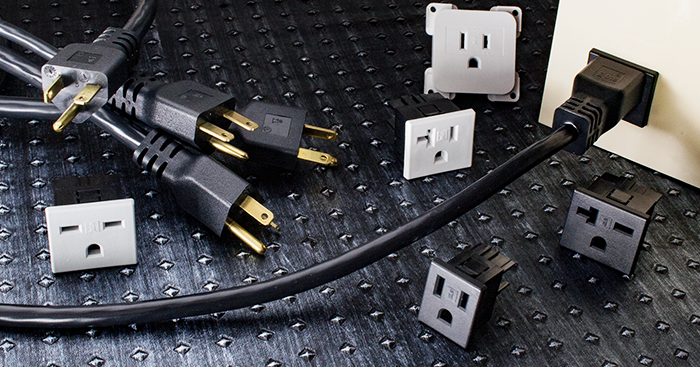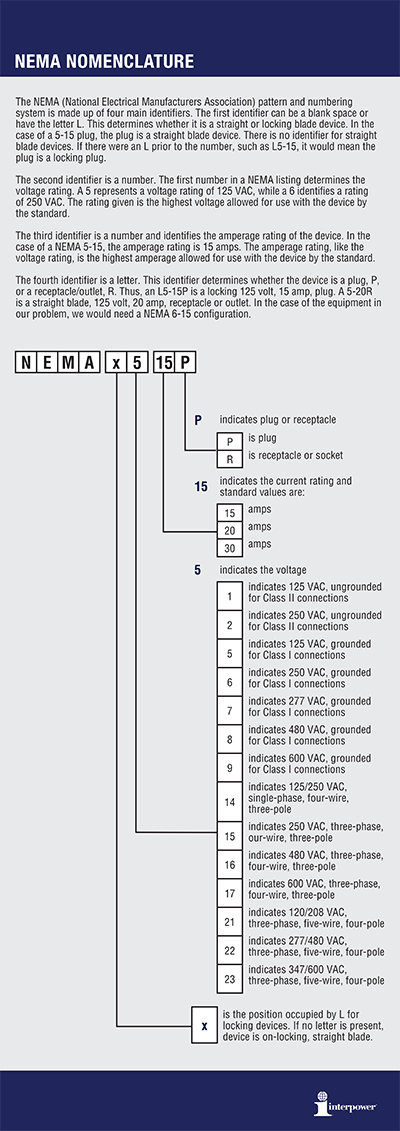Safe Connections with NEMA Plugs and Sockets
Posted on 8/26/19 8:06 AM

The configurations on NEMA plugs and sockets are designed to assist in keeping electrical connections safe.
North American plugs and sockets are described in standards published by the National Electrical Manufacturer’s Association (NEMA) in the United States and by the Canadian Standards Association (CSA) in Canada. The standards identify unique pin and socket configurations based on amperage and voltage ratings. Both straight blade and locking configurations are included in the standards with each blade position determined by the type it is designated for. For example, a 30 amp plug cannot be plugged into a 15 amp socket.
NEMA Nomenclature
The NEMA pattern and numbering system is made up of four main identifiers:
- The first identifier can be a blank space or have the letter “L”. This determines whether it is a straight or locking blade device. An example of this: a “5-15 plug” means the blades are straight, but a “L5-15 plug” means it is a locking plug.
- The second identifier is a number. The first number listed determines the voltage rating. A “1” identifies that it is rated for 125V, Class II. A “5” identifies it is rated for 125V, Class I. A “6” identifies it is rated at 250V, Class I. The rating given is the highest voltage allowed for a device by the standard.
- The third identifier is a number and it identifies the amperage rating for the device. A 5-20 has a rating of 20 amps. The amperage rating, like the voltage rating, is the highest amperage allowed for use with the device by the standard.
- The fourth identifier is a letter. The identifier determines whether the device is a plug, “P”, or a receptacle (socket), “R”. If there is no letter on the fourth position, it is assumed the device is a plug. A L5-15P is a locking, 125V, 15 amp plug. A 5-20R is a straight blade, 125V, 20 amp receptacle/socket.
NEMA Plugs and Sockets
Each NEMA plug and socket has an amperage and a voltage rating. The ratings are determined by the standards agencies and are often slightly higher than the actual current measurement at use. In the United States, the National Electrical Code (NEC) limits the continuous current through a connection. A socket rated at 15 amps is limited to a continuous output of 12 amps. The rating on an assembly is valid only when the consumer uses it in an application for which it was intended and rated.
At Interpower, the most frequently specified NEMA plug patterns include: Class II 1-15 (polarized and non-polarized) and Class I 5-15, 5-20, 6-15, and 6-20. NEMA sockets are available in a snap-in or screw-mount styles with quick disconnect or solder tab options. Four snap-in sockets at Interpower utilize the same cutout size. The screw-mount sockets also have a common panel cutout dimension.
Current ratings for some of the most common NEMA plug patterns include:
- 1-15—15A/125VAC
- 5-15—15A/125VAC
- 5-20—20A/125VAC
- 6-15—15A/250VAC
- 6-20—20A/250VAC
Additional Resources
For more information, see the Interpower Plugs and Sockets product page, the Featured Product page, the NEMA Nomenclature Guide, and the North American Non-Locking NEMA Configurations Guide.
Interpower offers value-added services and free technical support. For further assistance, please see Interpower’s contact information below.
Topics: Designing for North America, safety, NEMA plugs, NEMA Sockets





